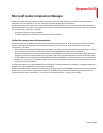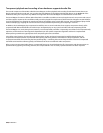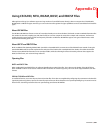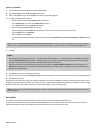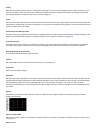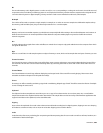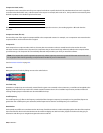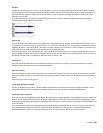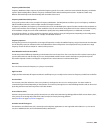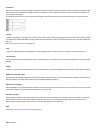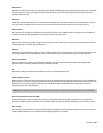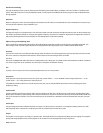Bit
The most elementary unit in digital systems. Its value can only be 1 or 0, corresponding to a voltage in an electronic circuit. Bits are used
to represent values in the binary numbering system. As an example, the 8-bit binary number 10011010 represents the unsigned value of
154 in the decimal system. In digital sampling, a binary number is used to store individual sound levels, called samples.
Bit Depth
The number of bits used to represent a single sample. For example, 8- or 16-bit are common sample sizes. While 8-bit samples take up
less memory (and hard disk space), they are inherently noisier than 16- or 24-bit samples.
Buffer
Memory used as an intermediate repository in which data is temporarily held while waiting to be transferred between two locations. A
buffer ensures that there is an uninterrupted flow of data between computers. Media players may need to rebuffer when there is
network congestion.
Bus
A virtual pathway where signals from tracks and effects are mixed. A bus's output is a physical audio device in the computer from which
the signal will be heard.
Byte
Refers to a set of 8 bits. An 8-bit sample requires one byte of memory to store, while a 16-bit sample takes two bytes of memory to store
Channel Converter
The Channel Converter is a function that converts files from mono to stereo and stereo to mono with independent level control of the
new channels. This function can also create interesting effects by converting stereo files to stereo with various levels and inversion of
channels.
Channel Meters
The Channel Meters in Sound Forge software display the peak output levels of the sound file currently playing. These meters have
selectable resolution and options to hold peaks and valleys.
Chorus
Chorusing is an effect created by combining a signal with a modulating, delayed copy of itself. This effect creates the illusion of multiple
sources creating the same sound.
Clipboard
The clipboard is where sample data is saved when you cut or copy it from a data window. You can then paste, mix, or crossfade the
sample data stored on the clipboard with another data window. This sample data can also be used by other Windows applications that
support Sound data on the clipboard, such as Sound Recorder.
Clipping
Occurs when the amplitude of a sound is above the maximum allowed recording level. In digital systems, clipping is seen as a clamping
of the data to a maximum value, such as 32,767 in 16-bit data. Clipping causes sound to distort.
Codec
Coder/Decoder: refers to any technology for compressing and decompressing data. The term codec can refer to software, hardware, or a
combination of both technologies.
APPENDIX E | 345



